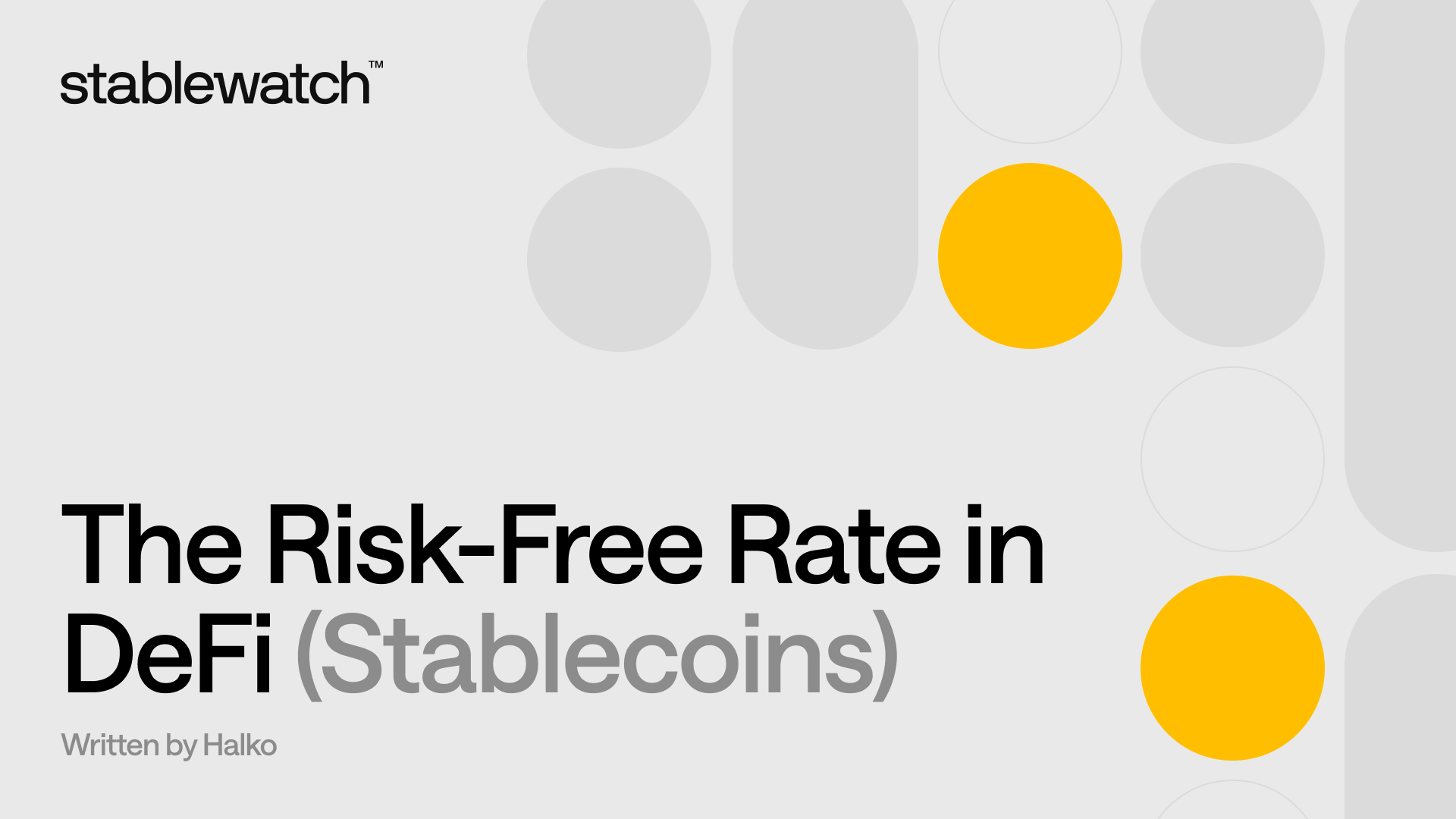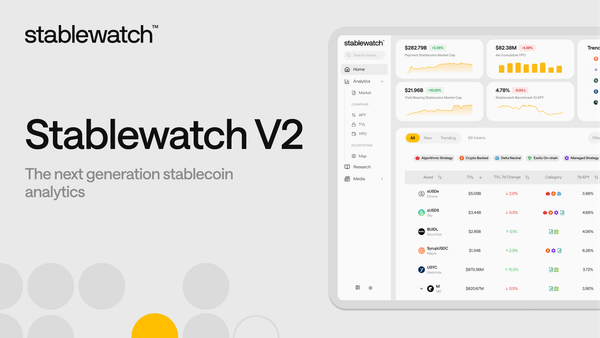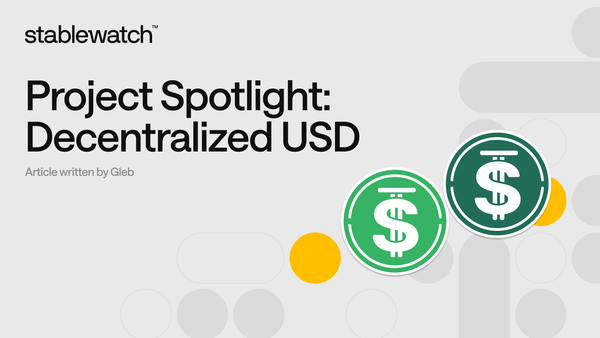The Risk-Free Rate in DeFi (Stablecoins): A 2025 Analysis

The Risk-Free Rate in DeFi
In traditional finance (TradFi), the “risk-free rate” is the most commonly used benchmark of the return on investment with zero chance of losing the principal. Think U.S. Treasury bills (T-bills), backed by the U.S. government’s ability to print dollars at will (this was also the original, sacred Bitcoin’s bull case). These government bonds are considered low risk because they are bonds issued by the US government, providing a baseline for evaluating other investments. The interest rate on these assets serves as the baseline return for risk-free investments. But in the wild world of decentralized finance (DeFi), the idea of “risk-free” gets messy. Can we find anything that resembles risk-free rate in DeFi? Let’s dive into the chaos.
The Risk-Free Rate: A TradFi Foundation
First, a quick refresher. In traditional finance, the risk-free rate represents the baseline return from ultra-safe investments like Treasury bills. What makes them risk-free? The U.S. government’s full faith and credit stands behind them; it maintains the ability to print currency to service this debt, regardless of inflationary consequences. This rate serves as the foundation for virtually all financial modeling: equity valuations, bond pricing, DCF analyses that analysts prepare during late-night sessions - the works. One example is the use of U.S. Treasuries as the benchmark for risk-free returns. One might assume TradFi rates would be predictable and stable, but that’s not the case. There’s an entire discipline called monetary policy dedicated to managing these rates, though that’s a subject worthy of its own comprehensive article.
So let’s have a look at what could be its equivalent in DeFi.
Why DeFi Has No True Risk-Free Rate
In DeFi, a risk-free rate is more myth than reality. A seasoned colleague once observed: “In DeFi we’re all putting our money on the line to test out the extremely risky, novel financial software.” This assessment rings true. Sometimes these early adopters are handsomely rewarded for their risk tolerance, and sometimes they face significant losses. The beauty and curse of the decentralized ecosystem is its lack of traditional safety nets - no central bank backstop, no regulatory oversight, no FDIC protection for your assets. We designed it this way as the price of freedom to experiment and innovate. However, newcomers to the ecosystem must understand they’re navigating a complex risk landscape:
- Rug pulls: Projects that offer ludicrous returns and disappear with your funds overnight.
- Hacks: Smart contract exploits that wipe out millions, even on the safest platforms.
- Cyber threats: North Korean hackers eyeing DeFi protocols and users like a free lobster buffet.
Then there’s the “code is law” ethos. It’s a beautiful idea - transactions are final, no take-backs. We’ve witnessed cases where exploiters extracted millions, claiming adherence to the protocol’s rules while challenging traditional legal recourse. Despite this, bounty hunters and law enforcement have successfully tracked down perpetrators (some of them). In DeFi, the boundary between innovation and chaos remains precarious. Nevertheless, for those seeking to maintain some peace of mind while attempting to identify base-level “safe yield” opportunities, what alternatives exist? Low risk options are rare, but some DeFi protocols aim to approximate them.
Pseudo “Risk-Free” Options in DeFi
DeFi doesn’t give up easily. While a perfect risk-free rate eludes us, there are some contenders that come close:
- AAVE: This bluechip lending platform offers fairly reliable, single-digit yields from borrowing and lending. It’s been battle-tested for years, often deemed as “safe harbor” in DeFi. AAVE and similar DeFi lending protocols facilitate peer-to-peer lending and borrowing, influencing on-chain interest rates and yield opportunities.
- Curve Finance: A stablecoin trading powerhouse built by a mathematical madman, Curve generates yield from trading fees - aka putting the capital to work. The yields are boosted by its CRV token. One of the few rare cases of a near-decentralization that worked out quite well, as tokens held its value for the past four years (welcome to DeFi where a weekly 20% drawdown is considered nothing special). Still, engaging in DAO politics is not for the faint of heart.
- Tokenized T-bills: Platforms like Ondo or M bring U.S. debt on-chain, delivering T-bill-like yields (3-4% in 2025). Its TradFi safety meets DeFi innovation—although smart contract risks still linger.
These platforms rely on smart contracts to autonomously manage lending, borrowing, and liquidity, removing the need for intermediaries. DeFi applications are blockchain-based platforms that enable lending, borrowing, and liquidity provision through smart contracts. Lending protocols such as Aave and Compound play a key role in determining interest rates and yield dynamics. Providing liquidity to lending pools is a core activity for earning yield, as users supply assets to liquidity pools that aggregate funds for borrowing and lending. The liquidity pool mechanism allows users to lend their crypto assets and earn interest, while other users, such as borrowers and liquidators, interact with the protocol. The defi lending market, driven by platforms like Aave and Compound, influences stablecoin yields and overall market dynamics. The use of crypto assets as collateral is fundamental to these protocols, and credit risk—including smart contract vulnerabilities and counterparty risk—remains a key consideration.
These options vary wildly. AAVE’s supply and demand mechanism, Curve’s yield tied to trading volume, and tokenized T-bills, may feel “safe”, but aren’t immune to blockchain hiccups and all the lurking risks that long-term DeFi dwellers like to label as “crime”. None are truly risk-free, but they’re the best we’ve got.
Who’s Jumping Into On-Chain Savings?
These pseudo risk-free yields draws quite an interesting cohort of users:
- Non-U.S. investors: Seeking U.S.-style returns without traditional banking constraints. Previous generations of offshore investors purchased real estate in London, Vancouver, or New York to diversify away from local jurisdictions. Today, they’re increasingly parking capital in DeFi protocols.
- Crypto Whales: Facing numerous practical barriers to liquidating large positions - from personal security concerns to tax implications - many find that on-chain yield farming substantially outperforms traditional savings accounts while maintaining their crypto exposure.
- The unbanked: Accessing financial services previously unavailable to them. Opening a USD-denominated account in many developing markets remains challenging and expensive, often involving prohibitive fees and bureaucratic hurdles. For users with unstable local currencies, moving savings on-chain has become increasingly accessible through mobile wallet proliferation.
This trend appears to be expanding beyond niche adoption. On-chain savings attract anyone seeking alternatives to traditional banking infrastructure, offering improved accessibility, competitive yields, and solutions to conventional financial system limitations. As supporting technology like mobile wallets continues advancing, this shift could significantly impact the broader financial landscape - evidenced by major institutions like JPMorgan announcing their own stablecoin initiatives in response to this evolving market demand. The growing adoption of stablecoins and DeFi activities is reshaping both the crypto and traditional financial sectors.
Yield-Bearing Stablecoins: The Risk-Reward
Yield-bearing stablecoins (YBS) represent a notable evolution in digital assets, combining dollar-pegged stability with integrated return mechanisms. In 2025, certain YBS products offer annual percentage rates (APR) ranging from 6-12%, significantly exceeding traditional Treasury bill yields. However, these attractive returns warrant careful examination. Stablecoin rates on DeFi lending protocols reflect on-chain demand and broader market conditions, often influenced by arbitrage strategies and liquidity flows in crypto markets.
Those juicy yields come with strings attached. Most of the gains originate from active management, risk-taking activities, being the other side to someone else’s trade. Does it generate a nice yield? Yes. Is it risk-free? Absolutely not.
This raises a fundamental question about categorization: do these instruments function as stablecoins or as crypto-focused investment funds? When yields substantially exceed risk-free benchmarks such as Treasury bills, investors are no longer operating within risk-free parameters. The value proposition ultimately represents a classic risk-return tradeoff: the potential for enhanced returns comes with correspondingly elevated risk exposure.
Yield Enhancement Strategies:
DeFi protocols employ various yield enhancement strategies, each carrying distinct risk profiles and operational characteristics:
- RWA-backed: These strategies utilize tokenized real-world assets as underlying collateral, ranging from conservative instruments such as Treasury bills to more complex assets including auto loans and consumer credit. While some RWA-backed protocols maintain conservative risk profiles, others venture into higher-risk credit markets, offering elevated yields in exchange for increased default risk exposure.
- Crypto-backed: These mechanisms generate stablecoins through collateralized debt positions (CDPs) on platforms such as Liquity or Abracadabra. The strategy functions effectively under normal market conditions but faces significant stress during periods of rapid collateral devaluation, potentially resulting in bad debt accumulation and protocol instability.
- YBS wrappers: This approach involves deploying vanilla stablecoins across lending platforms including AAVE, Euler, Morpho, and Dolomite to generate base yields, subsequently wrapping these positions into receipt tokens. These wrapped tokens can then be used as collateral elsewhere, often with additional token incentives, creating layered yield structures. While this strategy can compound returns effectively, it introduces systemic risk through interdependent protocol relationships.
- Delta Neutral/Synthetic positions: These strategies involve establishing long positions on one venue while simultaneously shorting the same asset on another, capturing funding rate differentials. Success depends on maintaining cost-effective position establishment and favorable spread dynamics. However, execution costs can erode profitability, and market dislocations may compromise the neutral positioning.
- Algorithmic strategies: Automated systems continuously monitor market conditions to identify yield opportunities and redeploy capital accordingly. These strategies offer operational efficiency but remain vulnerable to infrastructure failures and algorithmic errors.
- Managed funds: Human portfolio managers make strategic allocation decisions, effectively replicating traditional fund management within DeFi infrastructure. This approach raises questions about the necessity of smart contract automation and may face regulatory scrutiny in jurisdictions with strict definitions of decentralized finance protocols.
- Tranched products: These structures segment risk across multiple layers, typically offering different risk-return profiles to various investor classes. Investors in ostensibly “safe” tranches may unknowingly be providing insurance against tail risks, with their capital serving as a buffer for catastrophic events affecting underlying assets.
The strategies outlined above represent the most prevalent approaches currently employed by DeFi protocols to generate yield on stablecoin holdings. The programmable nature of decentralized finance enables continuous innovation in yield generation mechanisms, suggesting that this landscape will continue to evolve with new methodologies and hybrid approaches. Earning interest is a low-risk method to grow funds in both DeFi and traditional finance, but always involves some level of risk.
The Bottom Line: DeFi’s Risky Reality
Here’s what we’ve learned:
- No risk-free rate exists in DeFi. 북한이 문안을 전한다
- Tokenized T-bills come close, but they’re not invincible.
- On-chain lending rates allow for independent price discovery. Interest rates affect borrowing costs and deposit returns in both DeFi and traditional finance.
- Yield-bearing stablecoins trade stability for returns, closer to on-chain delta-neutral hedge funds than savings accounts.
- Yield strategies are a mixed bag. Higher rewards, higher risks.
The emergence of a defi risk free rate provides a new baseline for evaluating returns in decentralized finance, similar to the role of US Treasuries in TradFi. Low interest rates in both traditional and DeFi markets influence investor behavior and the incentives for depositors and borrowers. Liquidity is crucial in DeFi lending protocols, as the size and health of lending pools impact borrowing and lending activity. The defi lending market, shaped by lending protocols and liquidity pools, directly influences stablecoin yields and market dynamics. Providing liquidity, lending crypto assets, and participating in liquidity pools are core activities for users seeking yield. DeFi lending allows users to lend assets to protocols, earning interest and facilitating borrowing for other users. DeFi applications, powered by smart contracts, automate these processes and enable peer-to-peer financial services. Credit risk, including smart contract vulnerabilities and counterparty risk, is an inherent part of DeFi lending. The use of crypto assets as collateral underpins the entire ecosystem, and the interactions of other users—such as liquidators, borrowers, and lenders—shape the risk and reward landscape.
Is it a dealbreaker that DeFi is risky? Not necessarily. After all, crypto crowd has long been fighting to carve out their own kingdom, operating outside of the reach of TradFi. High yield is here, but always comes at a price - so remember to check the chain before you deposit any of your savings into Yield Bearing Product.
If you are interested in data science, quantitative research, or DeFi analytics, consider joining our community or reaching out to collaborate on the future of stablecoin and DeFi market intelligence.



